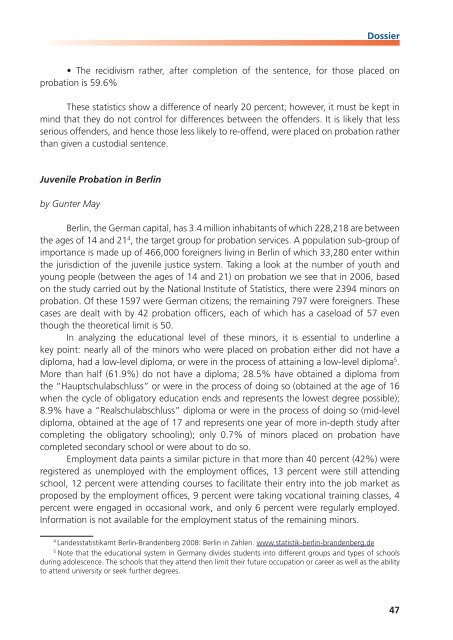Scarica il documento - Dipartimento per la Giustizia Minorile
Scarica il documento - Dipartimento per la Giustizia Minorile
Scarica il documento - Dipartimento per la Giustizia Minorile
Create successful ePaper yourself
Turn your PDF publications into a flip-book with our unique Google optimized e-Paper software.
Dossier<br />
• The recidivism rather, after completion of the sentence, for those p<strong>la</strong>ced on<br />
probation is 59.6%<br />
these statistics show a difference of nearly 20 <strong>per</strong>cent; however, it must be kept in<br />
mind that they do not control for differences between the offenders. it is likely that less<br />
serious offenders, and hence those less likely to re-offend, were p<strong>la</strong>ced on probation rather<br />
than given a custodial sentence.<br />
Juven<strong>il</strong>e Probation in Berlin<br />
by Gunter May<br />
Berlin, the German capital, has 3.4 m<strong>il</strong>lion inhabitants of which 228,218 are between<br />
the ages of 14 and 21 4 , the target group for probation services. a popu<strong>la</strong>tion sub-group of<br />
importance is made up of 466,000 foreigners living in Berlin of which 33,280 enter within<br />
the jurisdiction of the juven<strong>il</strong>e justice system. taking a look at the number of youth and<br />
young people (between the ages of 14 and 21) on probation we see that in 2006, based<br />
on the study carried out by the National institute of statistics, there were 2394 minors on<br />
probation. of these 1597 were German citizens; the remaining 797 were foreigners. these<br />
cases are dealt with by 42 probation officers, each of which has a caseload of 57 even<br />
though the theoretical limit is 50.<br />
in analyzing the educational level of these minors, it is essential to underline a<br />
key point: nearly all of the minors who were p<strong>la</strong>ced on probation either did not have a<br />
diploma, had a low-level diploma, or were in the process of attaining a low-level diploma 5 .<br />
More than half (61.9%) do not have a diploma; 28.5% have obtained a diploma from<br />
the “Hauptschu<strong>la</strong>bschluss” or were in the process of doing so (obtained at the age of 16<br />
when the cycle of obligatory education ends and represents the lowest degree possible);<br />
8.9% have a “realschu<strong>la</strong>bschluss” diploma or were in the process of doing so (mid-level<br />
diploma, obtained at the age of 17 and represents one year of more in-depth study after<br />
completing the obligatory schooling); only 0.7% of minors p<strong>la</strong>ced on probation have<br />
completed secondary school or were about to do so.<br />
employment data paints a sim<strong>il</strong>ar picture in that more than 40 <strong>per</strong>cent (42%) were<br />
registered as unemployed with the employment offices, 13 <strong>per</strong>cent were st<strong>il</strong>l attending<br />
school, 12 <strong>per</strong>cent were attending courses to fac<strong>il</strong>itate their entry into the job market as<br />
proposed by the employment offices, 9 <strong>per</strong>cent were taking vocational training c<strong>la</strong>sses, 4<br />
<strong>per</strong>cent were engaged in occasional work, and only 6 <strong>per</strong>cent were regu<strong>la</strong>rly employed.<br />
information is not ava<strong>il</strong>able for the employment status of the remaining minors.<br />
4 <strong>la</strong>ndesstatistikamt Berlin-Brandenberg 2008: Berlin in zahlen. www.statistik-berlin-brandenberg.de<br />
5 Note that the educational system in Germany divides students into different groups and types of schools<br />
during adolescence. the schools that they attend then limit their future occupation or career as well as the ab<strong>il</strong>ity<br />
to attend university or seek further degrees.<br />
47





